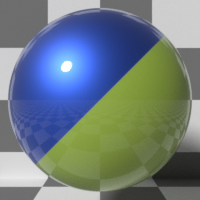
The Universal MaterialThe representation of the surface or volume properties of an object. combines several material types into a single material. It's compatible with maps created by applications like Substance Painter, based on a PBRA contemporary shading and rendering process that seeks to simplify shading characteristics while providing a more accurate representation of lighting in the real world. Metallic/Roughness workflow.


TransmissionA surface characteristic that determines if light may pass through a surface volume. - Controls the light passing through the surface of the material via refraction.
Transmission Type - Controls the transmission type:
Albedo - The material's base color.
Metallic - The material's metallic appearance. Blends between a dielectric and metallic material.
Specular - The color of specular reflections for the dielectric material.
BSDF Model - Determines how light is reflected. See BRDF Models for details.
Roughness - Roughness values for the Specular reflection and Transmission channels.
Anisotropy - Anisotropy values for the Specular and Transmission channels. A value of -1 is horizontal, while 1 is vertical. A value of 0 is Isotropic.
Rotation - Rotation values for the Anisotropic Specular reflection and Transmission channel.
Dielectric IOR - The Index Of Refraction controlling the Fresnel effect of the Specular reflection or Transmission channels. By default, if Dielectric 1/IOR Map is 0 (unconnected), then the dielectric specular layer uses this IOR.
Dielectric 1/IOR Map - The Index Of Refraction map. Each texel represents 1/IOR. When this is not empty, it overrides the Dielectric IOR setting.
Metallic Reflection Mode - Changes how reflectivity is calculated for the metallic material. By default, reflections use Schlick's Approximation for the Fresnel effect. For a more physically accurate falloff, you can enter a complex IOR (N/K values):
Metallic IOR N/K - Complex-valued Index Of Refraction (n-k*i), which controls the Fresnel effect of the Metallic material's specular reflection. For RGB mode, this serves as the Index Of Refraction for the red light (650nm).
Metallic IOR (Green) N/K - For RGB mode, this is the Index Of Refraction for the green light (550nm).
Metallic IOR (Blue) N/K - For RGB mode, this is the Index Of Refraction for the blue light (450nm).
Coating - The material's coating color.
Coating Roughness - The coating layer's roughness.
Coating IOR -The coating layer's IOR.
Coating Bump - The coating layer's Bump map. If you don't specify a Bump map, the coating layer uses the default shading normal. Otherwise, it applies the bump-mapped surface to the coating layer.
Coating Normal - The coating layer's Normal map. If you don't specify a Normal map, the coating layer uses the default shading normal. Otherwise, it applies the normal-mapped surface to the coating layer.
Film Width - The film coating's thickness.
Film IOR - The film coating's IOR.
Sheen - The material's sheen color.
Sheen Roughness - The Sheen channel's roughness.
Sheen Bump - The sheen layer's Bump map. If you don't specify a Bump map, the sheen layer uses the default shading normal. Otherwise, it applies the bump-mapped surface to the sheen layer.
Sheen Normal - The sheen layer's Normal map. If you don't specify a Normal map, the sheen layer uses the default shading normal. Otherwise, it applies the normal-mapped surface to the sheen layer.
Dispersion Coefficient - This is the B parameter of the Cauchy dispersion model. Increasing this value increases the coloration amount and dispersion in the layer's transmission and caustics.
Medium - Connects to a Medium node. See MediumsThe behavior of light inside a surface volume described by scatter, absorption, and transmission characteristics. for details.
Opacity - Controls the material's opacity with a Greyscale texture.
Fake Shadows - If enabled, light traces through the Material during the shadow calculation, ignoring refraction.
Affect Alpha - If enabled, this allows the Universal material's refractions to affect the Alpha ChannelA greyscale image used to determine which areas of a texture map are opaque and which areas are transparent..
Bump - Creates fine surface detail by simulating a relief using a Greyscale texture interpreted as a height map.
Normal - Creates fine surface detail by distorting normals using an RGB image.
DisplacementThe process of utilizing a 2D texture map to generate 3D surface relief. As opposed to bump and normal mapping, Displacement mapping does not only provide the illusion of depth but it effectively displaces the actual geometric position of points over the textured surface. - Adjusts the height of a surface's vertices at render time using a texture. See Displacement for details.
Smooth - Smooths surface normals. If this option is disabled, edges between polygons appear sharp, giving the surface a faceted look.
Round Edges - Connects to a Round Edges node. Rounds geometry edges by using a shading effect instead of creating additional geometry. See Round Edges for details.
Emission - Allows the material to emit light by connecting it to an Emission node. See Mesh EmittersThe ability for a surface to emit illumination usually described by a Black Body or Texture emission type. for details.
Shadow CatcherThe Shadow Catcher can be used to create shadows cast by objects onto the surrounding background imagery. The shadows cast are not limited to simply a ground plane but can be cast onto other surfaces of varying shapes. - Makes the material a shadow catcher, which captures shadows cast by other objects. It becomes visible in areas that are in shadows, while other areas become transparent.
Material Layer - Adds a Material Layer above the base material. See Material Layers for details.